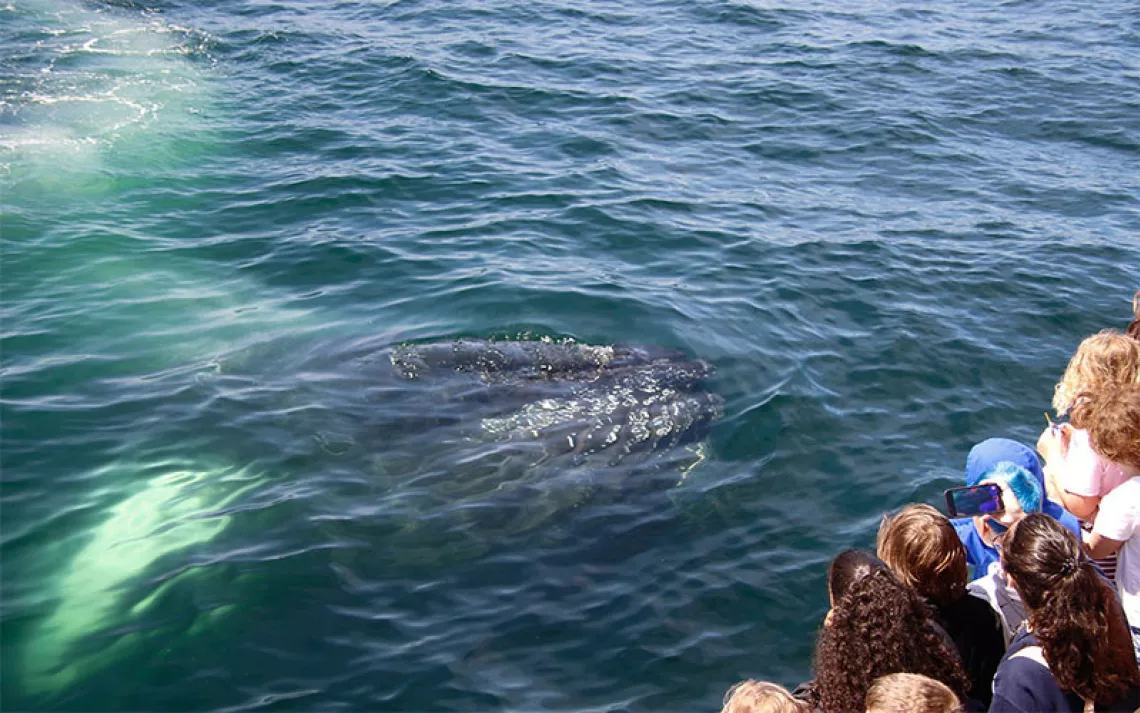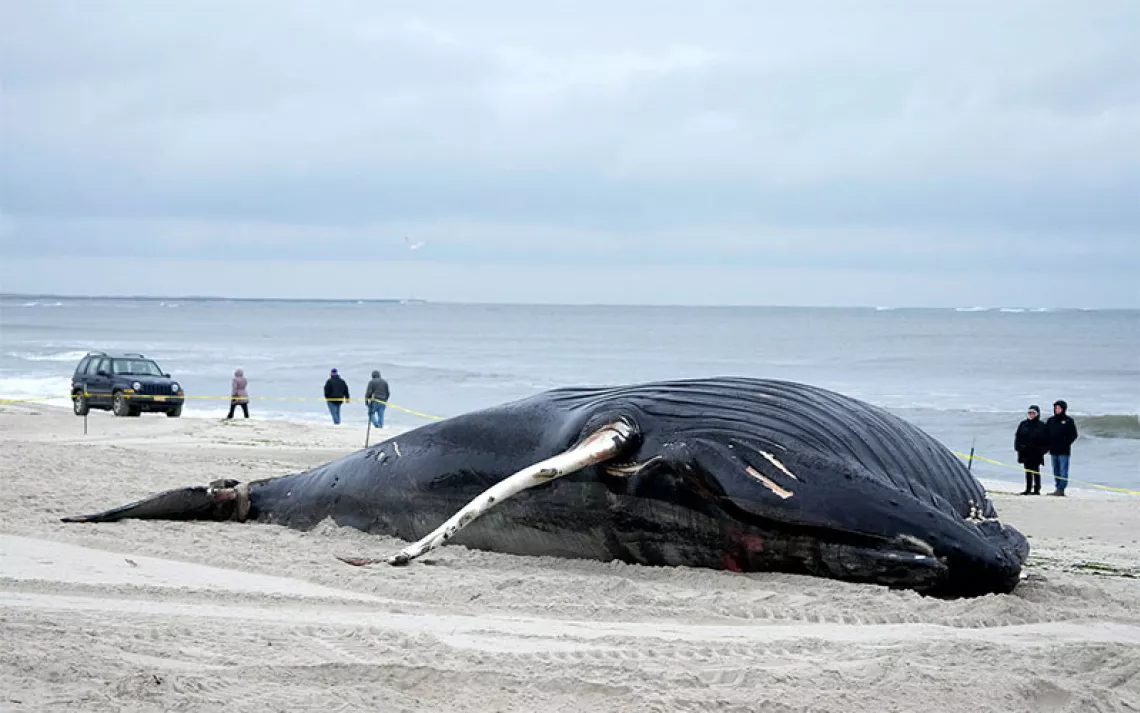Whatever Happened to "Save the Whales"?
We're still killing the creatures with the biggest brains on the planet—to make dog food

NOT LONG AGO I HAD the good fortune to freeze my knuckles off radio-tracking wolverines across the snowy mountainsides of Glacier National Park in Montana. So little is known about the lives of these animals that on any given day, at any moment, there is a chance to learn something new. Wolverine young are generally believed to be weaned and leaving their mother's side at six months, but we found them traveling with at least one parent--most often their father--for an entire year. And no one knew that wolverines still exist in California until a graduate student photographed one by accident last winter near Lake Tahoe.
Blaise Pascal, the 17th-century mathematician, physicist, and philosopher, offered an instructive proposition in regard to the human thought process: "We understand and believe vastly more than we know." Both as a scientist and a journalist, I've worked with mammals of many kinds around the world--big, long-lived, smart, socially complex, and evocative mammals such as elephants, jaguars, grizzlies, chimps, and gorillas. I've also been able to tag along with researchers studying various types of whales. As with wolverines (and so much else), we understand and believe vastly more about whales than we know.
This much is certain--the most colossal animal ever to appear on the planet happens to be alive today: the 90-foot-long, 100-ton blue whale. Even though commercial hunters had been killing whales and handling carcasses since at least the 14th century, it was 1692 before this titan was first scientifically described and 1693 before it was recognized as a mammal. Our knowledge of blue whale natural history hasn't improved a whole lot since then. During the late 1980s, the largest known surviving population of blue whales was discovered feeding right off the coast of California in summer and fall. Another decade passed before anyone found out where they go for the other half of the year.
You'd think we would have made a real push to get better acquainted with Earth's ultrafauna--the mega-most of its megafauna--before now. But whales roam far and deep across whole hemispheres, and back when they were abundant and easier to find, our focus was on harpooning every one we came near. Most of what they actually do out there in the boundless blue remains soaked in mystery. We have all kinds of things left to discover about some of the most advanced beings on the planet, from their basic habits to the ways in which they communicate, learn, remember, and think. Revelations await. So why are we killing these supermammals in the meantime?
BETWEEN 1920 AND THE '70S, whalers took more than 350,000 blue whales from Antarctic waters, the equivalent of about 400 million humans in weight. The principal target of commercial whaling today happens to be a smaller relative of the blue, the minke whale. We don't know much about it either. People thought minkes were silent until several years ago, when ocean scientist Jason Gedamke of the University of California at Santa Cruz discovered a repertoire of strange and amazing vocalizations in a population along Australia's Great Barrier Reef. Whale-watchers there float with snorkel gear while holding on to ropes attached to a boat. The minkes have been known to spend hours at a time investigating them. One lingered, gazing curiously for 11 hours, swimming against the current to stay close.
We are great admirers of our own brains and not at all sure what to do about minkes' big brains, not to mention blue whales with brains twice the size of ours, or orcas and sperm whales with brains up to four times larger. A common explanation is that because whales live in a world of waterborne sound, all that gray matter must be for processing acoustic information. We're primarily a visual species, but it doesn't take up much of the human cerebral cortex to make sense of visual information. The acoustic explanation's chief virtue is that it feels comfortable. Some people prefer measuring brain-to-body-weight ratios because it puts Homo sapiens at the head of the class. Right behind us, however, are some dolphins whose brain-to-body-weight ratios are higher than those of Australopithecus and other human predecessors.
Spindle neurons, which are associated with higher-order mental processes, were previously known only in people, great apes, and dolphins. In 2006 they were discovered in the brain cortex of humpback whales. So were brain structures called "islands," thought to make communication between nerve cells speedier and more efficient. Described by Herman Melville as "the most gamesome and lighthearted of all the whales," humpbacks give voice to the longest, most elaborate songs in the animal kingdom. They also convey information via explosive aerial leaps and displays that involve slapping their tail, chin, or long flippers on the water's surface. Their feeding strategies involve special calls, synchronized movements, a social division of labor, and--depending on how you interpret corralling fish in glistening nets of bubbles--the use of tools.
NO SPECIES SEEMS ANYWHERE nearly as skilled as humans, though, when it comes to twisting the truth. Through the transparent charade of "scientific whaling," designed to sidestep the global ban on commercial hunting imposed by the International Whaling Commission (IWC) in 1986, Japan is currently harpooning more than a thousand minkes annually. Over the years this "research harvest" has been expanded to include 50 fin and 5 to 10 sperm whales. Late last year Japan announced its intention to add 50 humpbacks. But then Australia condemned the move and threatened to send planes and a patrol boat to monitor the Japanese whaling fleet, and the United States lodged an unusually strong complaint as well. In response, Japan delayed its humpback hunt for up to two years.
Norway, which simply ignores the IWC moratorium on commercial whaling, is also killing around a thousand minkes annually and is steadily increasing its take. Iceland resumed industrial whaling in 2006, quit in 2007 when too few shoppers proved interested in buying steaks carved from warm-blooded submarines, but just announced plans to start again--despite the fact that whale-watching has become a multimillion-dollar industry in that nation. Greenland, a Danish territory, takes 187 minkes and 19 fin whales annually, along with hundreds of smaller narwhals and belugas, all under an IWC provision for "aboriginal subsistence whaling." This aboriginal hunting is done with modern weapons including grenade-tipped harpoons. (Even so, the death agonies of the fin whales impaled with such lances last up to two hours.) Greenland's total kill appears to be so much higher than necessary for subsistence that experts are concerned it may be causing declines in Arctic whale populations. The country is now lobbying to hunt humpbacks commercially.
Founded in 1946 by 15 whaling nations, the IWC has 78 member countries. Many have no history of whaling. Some, such as Mongolia and, more recently, Laos, lack even a seacoast (oddly, not a prerequisite of membership). This strange international interest in whaling policy can be partly explained by Japan's use of foreign-aid grants to entice other nations to join and support pro-whaling policies. By 2007 this faction had a one-vote edge. Fortunately, a wider majority is required to overturn the ban.

Sign up to receive Sierra News & Views
Get articles like this one sent directly to your inbox weekly.
With this action you affirm you want to receive Sierra Club communications and may vote on policy designated by the Sierra Club Board.
Japan's Ministry of Agriculture, Forestry, and Fisheries insists that whale flesh is an important source of food for its citizenry. Supply already exceeds demand, however, and investigators found companies rendering carcasses mainly for pet food. Japan likes to portray its whaling business as a cherished cultural tradition, though modern commercial whaling didn't start until 1898, and early Japanese whalers paddled small wooden vessels close to the coast, not aircraft-carrier-size factory ships stalking distant seas as they do now. Finally, the ministry touts the value of whaling in helping fish populations, warning that the giants are vacuuming them up. In truth, the collapse of commercial fish stocks is fully explained by the countless nets sweeping the world's waters--many of them from Japan's enormous fishing fleet. And most whales eat krill, plankton, and squid, not fish.
Why is Japan hell-bent on whaling? First seems to be a conviction that whales and dolphins are no different from fish and livestock; they're merely animals, and meat's meat. Second is a playground-age mind-set: "I'm going to do this because you told me not to." Or, as grown-ups say, "It's a matter of national pride."
The more pointed question is, whatever happened to "Save the whales"? True, Greenpeace and other conservation groups continue to battle on behalf of cetaceans. Paul Watson and his Sea Shepherd Conservation Society volunteers are still out there racing little inflatable skiffs between harpooners and their targets. (In a confrontation with the Japanese whaler Nishhin Maru last March, Watson reported being shot in the chest and saved by his Kevlar vest. Japan said no gunshots were fired.) But the general populace seems to have responded to the ongoing revival of whaling with a collective shrug. Yes, there was that flap over Japan's proposal to slaughter humpbacks, the most commonly watched and popular of the great whales. And the outcry got results. But the effort stopped there, leaving the fin, sperm, and minke whales dead center in the harpooners' sights.
IN MORE AND MORE SCIENTIFIC PAPERS about whales, I find two very promising phrases. One is "a quality formerly thought to be unique to humans." The second: "the social transmission of learned information." Any number of whales demonstrate both, as far as I can tell. Nevertheless, science is still having a terrible time using the common word for this phenomenon: culture.
Western society has been liberated from one myth after another by science. But the people-animal border is particularly well defended by social and religious precepts. Crossing it seriously threatens our sense of supremacy, our meaning and identity, Homo sapiens' cherished place as grand marshal leading the pageant of existence--in short, the whole framework we use to define our lives. Extending too many evocative mental and emotional qualities to animals also implies revising human activities that exploit other species. Our economic systems, not to mention our moral universe, are suddenly called into question.
This is a very uncomfortable place for science to be. Good. That's how you know you're on a true frontier, which is where a good scientist ought to be stationed. I don't know what the outcome will be. I'm not arguing in favor of "woo-woo" science or promoting cetaceans as gurus of the briny deep. But I do know that frontiers are where today's unthinkables turn into tomorrow's facts.
We are getting closer to a breakthrough in our understanding and beliefs about animals, and whales just might be the ones to push us to the other side. They have the power and majesty to change how the game is played and the juice to change ideas about us being the pinnacle and purpose of creation. If they do, we'll have no choice but to abandon our self-imposed isolation chamber and enter into a true communion with nature.
 The Magazine of The Sierra Club
The Magazine of The Sierra Club



